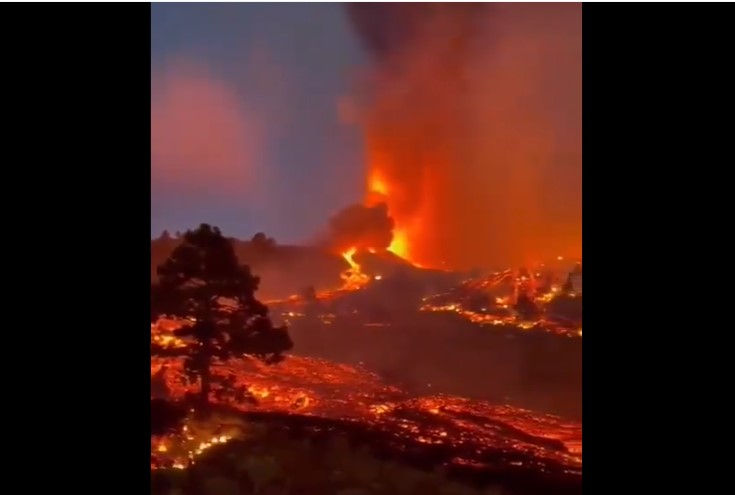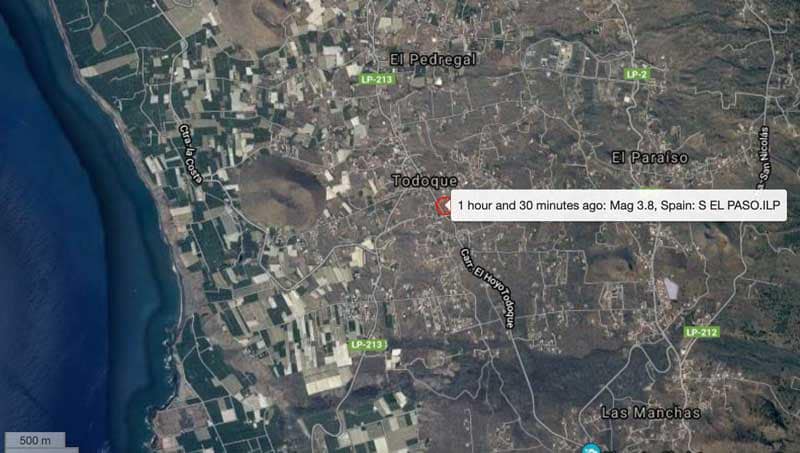
The eruption is still in progress in La Palma. The wall of incandescent lava is 6-meter-high on average and travels at a speed of 700 meters per hour, destroying everything, from homes to electrical and telephone communication masts, on its way towards the sea.
Meanwhile, the lava flow from the volcano that erupted on Sunday in La Palma, in Spain’s Canary Islands, is close to reaching the sea, its natural outlet.
This situation is of concern to authorities as the reaction of lava in contact with saltwater “could lead to explosions and the emission of toxic gases,” according to the crisis team at the Canary Islands Volcano Emergency Plan (Pevolca).
An exclusion zone has been established in the sea, running parallel to the coast, and extending from Puerto Naos in the south of the island to Las Viñas beach in Tazacorte in the north. On land, security forces will prevent access to the area.
Scientists thought that the lava flow would reach the coast at around 8pm on Monday night, local time. However, the advance of the rivers of molten rock slowed and this forecast was not met.
Miguel Ángel Morcuende, the technical chief of Pevolca, explained last night: “We have had less activity in the volcano, less volume of magma mass. The activity of the volcano is slowing. The lava flow is in the Todoque neighborhood. It is still halfway to the sea. It is not going to arrive tonight.”
Drone footage shows homes being consumed by the lava flow at #LaPalma. Lava flows are slow enough to give us time to evacuate, but we can’t stop them from bulldozing their way through anything in their path. Slow but devastating. pic.twitter.com/NXRMO9g48n
— Dr. Kayla Iacovino (@kaylai) September 21, 2021
Explosion and toxic gases
When the lava, which has a temperature of around 1,000ºC, reaches the sea, which is little over 20ºC, experts say there will be an explosion of water steam that will create a dense white cloud. This plume is caused by the lava flow due to its extreme heat. But the molten rock will also trigger a chemical reaction, mainly of chlorine, which can irritate the skin, eyes and respiratory system.
According to the US Geological Service, there are four main dangers linked to the ocean entry of lava:
- The sudden collapse of new land and adjacent sea cliffs into the ocean
- Explosions triggered by the collapse
- Waves of scalding hot water washing onshore
- Steam plume that rains hydrochloric acid and tiny volcanic glass particles downwind from the entry point.
But the interaction of the sea with a volcano is not always destructive, as was seen in the 2011 eruption of an underwater volcano in the Canary Island of El Hierro.
New fissure and around 6,000 evacuated
The volcano on La Palma, the first that has erupted in Spain since 1971, has had the island on tenterhooks since it started to shoot out fire, smoke and ash on Sunday.
Until now, the fissures that opened up in the Montaña Rajada mountains in the municipality of El Paso have emitted a lava flow measuring an average of six meters high – as tall as a two-story building.
If you want to know where the lava flow on La Palma is, here’s a link to a google map overlay from Copernicus data. https://t.co/7OW0wpXYxs
— Knud Jahnke (@KnudJahnke) September 21, 2021
Satellite images taken by the European Space Agency reveal that these lava flows have destroyed more than 166 buildings and covered more than 100 hectares.
On Monday night, La Palma was hit by an earthquake measuring 3.8 on the Richter scale – the strongest since the eruption began, according to the National Geographic Institute.

Shortly before the tremor, a new fissure opened up – the ninth to date – which prompted the evacuation of residents in the locality of Tacande.
? #ÚltimaHora | Surge nueva boca en la erupción en #LaPalma
?Se encuentra más abajo de la principal y hacia el norte. Sería la novena boca que tiene ya el #VolcandeLaPalma
Imágenes tomadas por los vecinos pic.twitter.com/d7H61RNiGq
— RTVC (@RTVCes) September 20, 2021
So far the eruption has not claimed any victims, but it has forced around 6,000 people to evacuate their homes.
The scene in the area was described on Monday as “devastating” by the president of the La Palma island council, Mariano Hernández Zapata, given that the lava “is literally eating up the houses, infrastructure and crops that it is finding on its path toward the coast in the valley of Aridane.”
Scientific research
Scientists on board the Ramon Margalef research ship are set to study the impact of the lava flows’ entry into the ocean. “The biggest impact will be on organisms that live attached to the ocean floor and can’t move, and which will probably die. But recovery could be fast. Three years after the eruption of the underwater volcano in El Hierro, these organisms had almost completely bounced back,” said Eugenio Fraile, a researcher at the Spanish Oceanographic Institute.
The National Geographic Institute (IGN) has created mathematical models to calculate the progress of the lava flows, based on the parameters of the lava and the characteristics of the land. With these maps, the scientists are trying to indicate the most likely routes the lava flows will follow.
While these calculations were made on the current situation of the volcano, where nine eruptive vents have opened up from two different fissures, scientists are not ruling out that more fissures will appear, which would change the flow.
Here’s the current lava flow hazard map:
Actividad volcánica #LaPalma #erupcionlapalma
Mapas de peligro de flujo de lavas.@CabLaPalma @112canarias @Marianohzapata pic.twitter.com/jLgRDFewSr— Volcanes de Canarias (@VolcansCanarias) September 20, 2021
According to Carmen López, the head of the Central Geophysics Observatory at the IGN, the magma is looking to escape and “different emission points could appear, but the mechanism is the same. It will not be another eruption, but we can’t rule out that other emission points or small fissures could emerge.”
The first estimates indicated that the volcano contains between 17 and 20 million cubic meters of lava, less than half the 43 million that were released by Teneguía when it erupted in 1971, but this is a preliminary estimate that must be revised.
You can read here the volcanic update of yesterday!
The magma flow will completely change the orography of the eruption site. The land will become unusable and uninhabitable. The 6-meter-high lava flow will bury some more land, and also probably disrupt electrical and telephone communications… And when the magma reaches the sea, it will create acid rain when. The apocalypse is near! [El Pais]
Now subscribe to this blog to get more amazing news curated just for you right in your inbox on a daily basis (here an example of our new newsletter).
You can also follow us on Facebook and/ or Twitter. And, by the way you can also make a donation through Paypal. Thank you!
You should really subscribe to QFiles. You will get very interesting information about strange events around the world.














https://www.thegatewaypundit.com/2021/09/george-w-bush-raising-money-bitter-never-trumper-liz-cheney/
I’m surprised a lava flow hasn’t mowed his bloodlines down. Look how many people died from his lies. Glad I never voted for this dirtbag. This is NOT a Conservative, nor are any rinos. They all work for satan, and I guarantee it. Either wittingly or unwittingly.
WOW, amazing video. Reminds me of the Hawaii destruction. It’s the same thing. Nothing will stop the lava flow from reaching the sea. it crushes everything in its path.
That slow moving wall of a’a lava is amazing!
Just creeping, creeping, pushing pushing, burning, burning its way to the sea.
Well enough, 6,000 people lost homes. Homes can be rebuilt. Happy that no people died. Six meter high lava flows sound pretty devastating. Probably animals got killed, or panicked.
Good luck on the rebuilding. I wouldn’t live near any volcanoes.
The human volcano will soon visit us all, how long will it take till you are in its path?